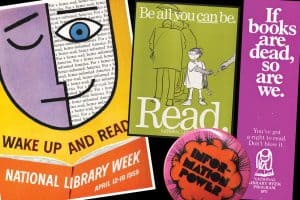
On April 5, the American Library Association (ALA) released its State of America’s Libraries Special Report: COVID-19, a snapshot of the library community’s resilience, determination, and innovation in unprecedented circumstances. The report, which comes out annually during National Library Week, this year April 4–10, focuses on the impact of the novel coronavirus on all types of libraries during the previous calendar year.
Like many public institutions forced to close their doors, libraries adapted to a new way of doing business. Closures did not prevent library workers and libraries from serving their communities. Instead, shuttered physical spaces fueled significant innovation and opportunities to assist and support patrons and students remotely.
As most libraries were closed to in-person visits, libraries accelerated or adopted policies that let users access resources from a safe distance, including offering digital library cards, creating curbside pickup programs, and promoting ebook lending, which surged 40% from 2019.
 Libraries played a key role in bridging a digital divide that became more apparent during the pandemic. Families, marginalized communities, students, and rural residents, in particular, struggled as the nation pivoted to virtual communication instead of in-person interactions and learning. Multiple studies cited in the report show that a significant proportion of the US population lacks access to computers and broadband internet. To help close this gap, many libraries left their Wi-Fi on even as their buildings closed.
Libraries played a key role in bridging a digital divide that became more apparent during the pandemic. Families, marginalized communities, students, and rural residents, in particular, struggled as the nation pivoted to virtual communication instead of in-person interactions and learning. Multiple studies cited in the report show that a significant proportion of the US population lacks access to computers and broadband internet. To help close this gap, many libraries left their Wi-Fi on even as their buildings closed.
The coronavirus also opened a floodgate of misinformation. Library staffers worked to eradicate misinformation about COVID-19, which was infused with xenophobia, resulting in a surge of bigotry against people of Asian, particularly Chinese, descent. Throughout 2020, librarians responded to misinformation about vaccines, the census, the Black Lives Matter movement, and the 2020 presidential election.
Banned and challenged books
Additional report findings show that attempts to remove library materials continued during the pandemic, despite many libraries and schools closing or moving their activities and services online. ALA’s Office for Intellectual Freedom tracks attempts to ban or restrict access to books across the country and to inform the public about censorship efforts in libraries and schools.
In 2020, more than 273 titles were challenged or banned. Demands to remove books addressing racism and racial justice or those that shared the stories of Black, Indigenous, or people of color grew in number. At the same time, books addressing themes and issues of concern for LGBTQIA+ people continued to dominate the list.
The top 10 most challenged books during 2020:
- George by Alex Gino. Challenged, banned, and restricted for LGBTQIA+ content, conflicting with a religious viewpoint, and not reflecting “the values of our community.”
- Stamped: Racism, Antiracism, and You by Ibram X. Kendi and Jason Reynolds. Banned and challenged because of the author’s public statements and because of claims that the book contains “selective storytelling incidents” and does not encompass racism against all people.
- All American Boys by Jason Reynolds and Brendan Kiely. Banned and challenged for profanity, drug use, and alcoholism and because it was thought to promote antipolice views, contain divisive topics, and be “too much of a sensitive matter right now.”
- Speak by Laurie Halse Anderson. Banned, challenged, and restricted because it was thought to contain a political viewpoint, it was claimed to be biased against male students, and it included rape and profanity.
- The Absolutely True Diary of a Part-Time Indian by Sherman Alexie. Banned and challenged for profanity, sexual references, and allegations of sexual misconduct on the part of the author.
- Something Happened in Our Town: A Child’s Story about Racial Injustice by Marianne Celano, Marietta Collins, and Ann Hazzard, illustrated by Jennifer Zivoin. Challenged for “divisive language” and because it was thought to promote antipolice views.
- To Kill a Mockingbird by Harper Lee. Banned and challenged for racial slurs and their negative effect on students, featuring a “white savior” character, and its perception of the Black experience.
- Of Mice and Men by John Steinbeck. Banned and challenged for racial slurs and racist stereotypes and their negative effect on students.
- The Bluest Eye by Toni Morrison. Banned and challenged because it was considered sexually explicit and depicts child sexual abuse.
- The Hate U Give by Angie Thomas. Challenged for profanity, and because it was thought to promote an antipolice message.
Other library trends are available in the full text of the State of America’s Libraries Special Report: COVID-19.
First sponsored in 1958, National Library Week is observed each April by ALA and libraries across the US. National Library Week celebrations include National Library Workers Day, April 6; National Library Outreach Day, April 7; and Take Action for Libraries Day, April 8. Additional National Library Week information is available at ilovelibraries.org, or follow #NationalLibraryWeek on social media.


